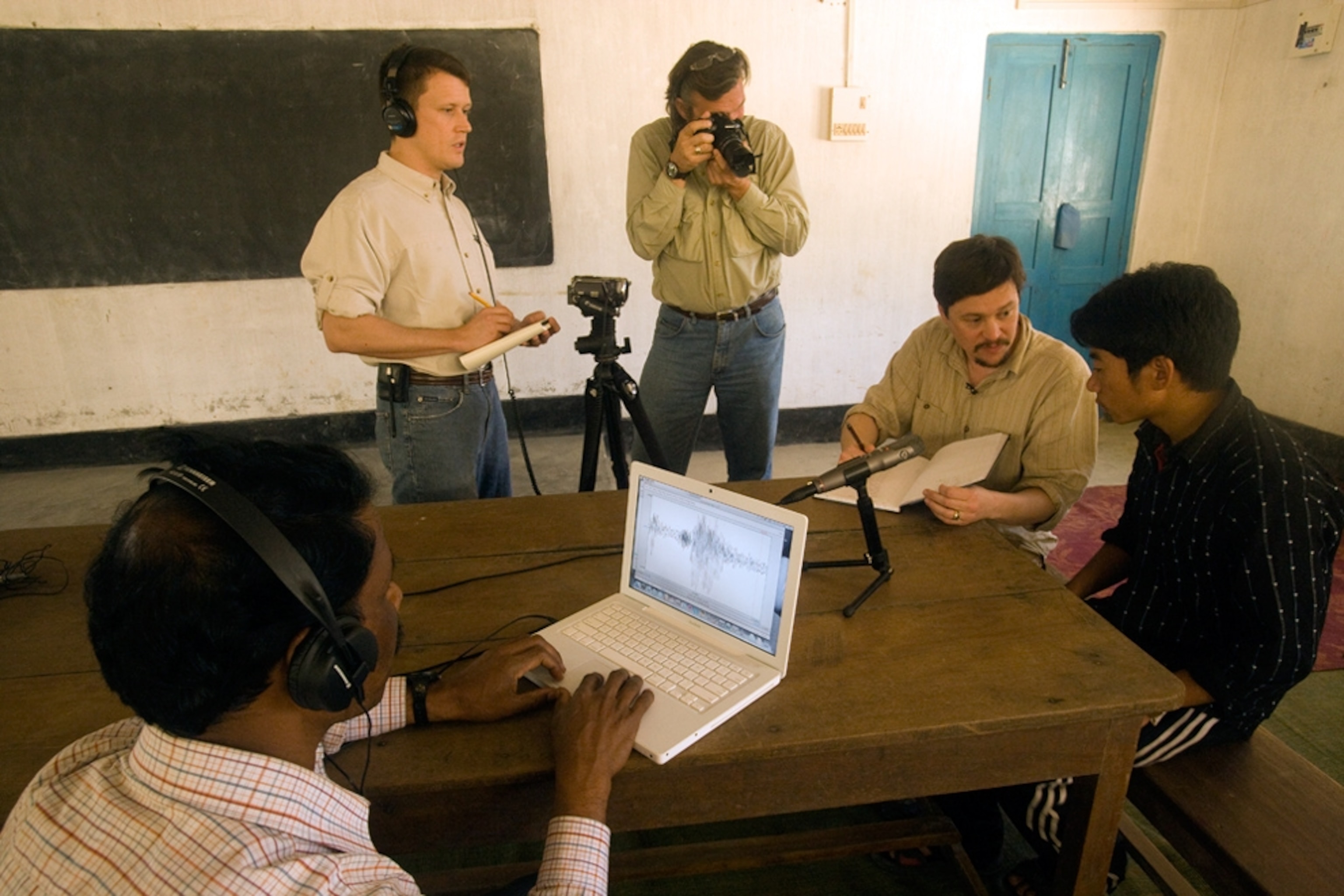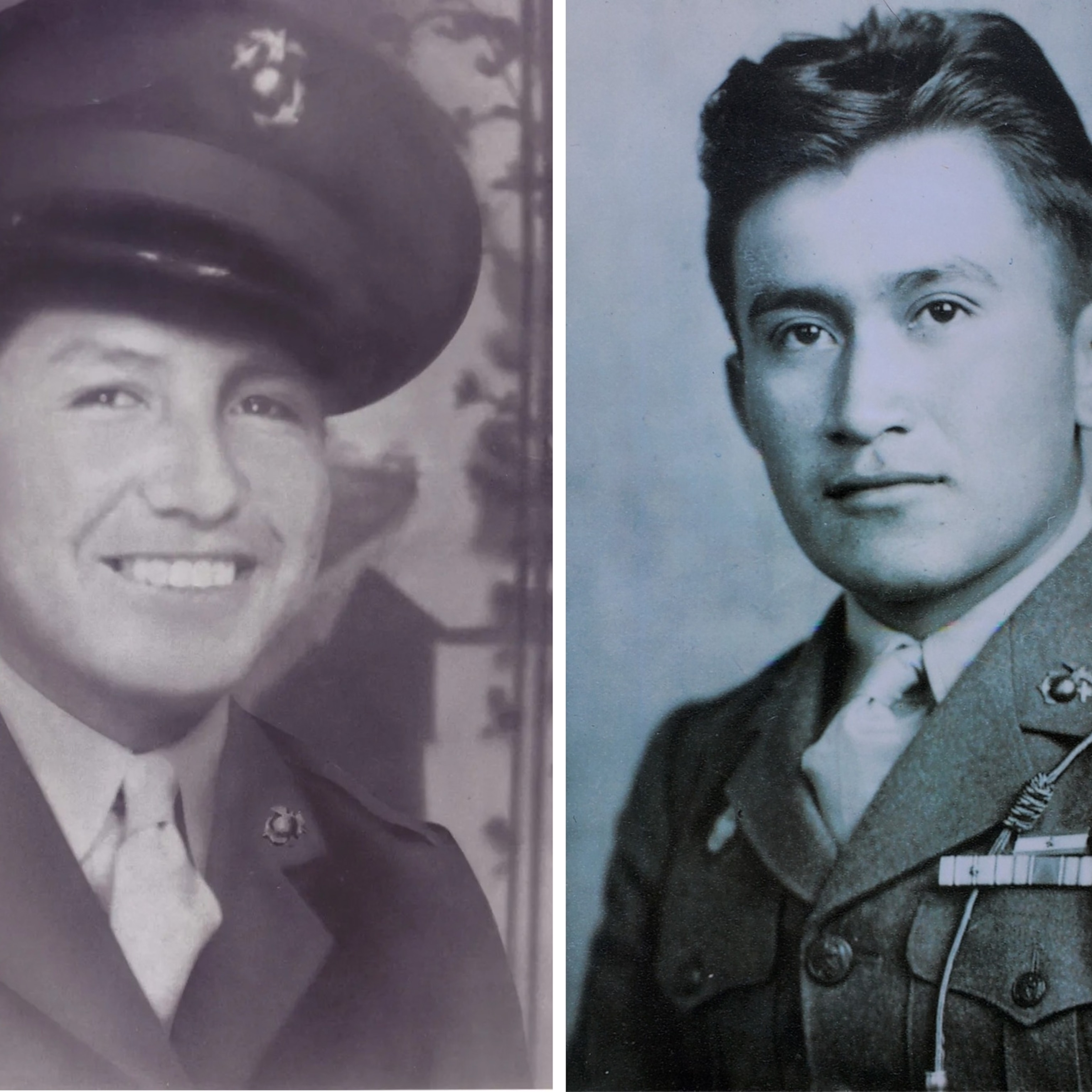
About Enduring Voices
Learn about National Geographic's Enduring Voices Project, working to document endangered languages. Get language facts, photos, map, and more.
Nearly 80 percent of the world's population speaks only one percent of its languages. When the last speaker of a language dies, the world loses the knowledge that was contained in that language. The goal of the Enduring Voices Project is to document endangered languages and prevent language extinction by identifying the most crucial areas where languages are endangered and embarking on expeditions to:
- Understand the geographic dimensions of language distribution
- Determine how linguistic diversity is linked to biodiversity
- Bring wide attention to the issue of language loss
When invited, the Enduring Voices Project assists indigenous communities in their efforts to revitalize and maintain their threatened languages.
The Language Hotspots model was conceived and developed by Greg Anderson and David Harrison at the Living Tongues Institute for Endangered Languages. It is a new way to view the distribution of global linguistic diversity, to assess the threat of language extinction, and to prioritize research. Hotspots are those regions of the world having the greatest linguistic diversity, the greatest language endangerment, and the least-studied languages.
Glossary
Terms Related to Languages and Language Endangerment
- Grammar
- Language Features
- Language Classification
- Language Contact
- Language Endangerment
Grammar
Descriptive grammar
An explanation of how a given language is spoken. A descriptive grammar does not judge what is good or bad usage, but instead records the language as it is spoken.
Documentation
The resources available about a language. Language documentation can include texts, scholarly articles, descriptive grammars, word lists or dictionaries, and audio and video recordings.
Genetic Index
The Enduring Voices team's calculation of how many language families, or genetic units, are present in an area relative to the total number of languages. The higher the genetic index of a region, the more varied its languages.
Interlinear Analysis
A method of showing linguistic information by placing analysis and translations between lines of text in the original language. Generally, an interlinear analysis has a transcription of the sounds of the original language on the first line, followed by a word-by-word or part-of-word analysis. The last line gives a translation into the language of the researcher.
Knowledge System
A collection of information and the way it is stored
Lexicon
In the context of documentation, a list of words, usually with definitions or translations. A dictionary is one familiar sort of lexicon.
Linguist
A person who studies linguistics
Linguistics
The scientific study of the world's languages. This includes the study of syntax, phonology, morphology, sociolinguistics, and other aspects of language. For an overview and articles on the subfields of linguistics, see the Linguistic Society of America's Web site, The Domain of Linguistics.
Morphology
The study of word structures; for example, how words are built using prefixes and suffixes
Phonetics
The study of speech sounds, including how they are produced in the vocal tract, how they are heard, and how they can be categorized
Phonology
The study of sound structures and patterns. This includes studying what sounds are used and how they are used in a given language (for example, English uses the sound ng, but never at the beginning of words), interactions of speech sounds, and explaining sound patterns theoretically.
Semantics
The study of meaning in language. This includes studying how the parts of a statement combine to produce its meaning.
Sociolinguistics
The study of language in its social context. This includes the study of dialects, the way people speak in different social contexts, attitudes toward languages and dialects, and many more areas. For more on sociolinguistics, see the PBS Web site Do You Speak American?
Syntax
The study of sentence structure and the rules that govern how words are combined to make grammatically acceptable sentences
Writing System
A set of symbols used to represent statements expressed in language. Alphabets, syllabaries, and raised notation systems are all forms of writing systems.
Language Features
Agglutinative Verb
Verbs built up using smaller meaningful parts. When these smaller parts are combined in the verb, they often keep the same form they have in other contexts in the language.
Basic Word Order
The order of the words in a standard sentence in a particular language. This reflects where the subject, object, and verb appear in a typical sentence. The phrase "English has SVO basic word order" follows SVO word order: The subject (English) appears first, followed by the verb (has) with the object (SOV basic word order) at the end. Other word orders are possible in English. For example, you could ask "Is English an SVO language?" This sentence has the verb "Is" before the subject. This does not change the basic word order of English; instead, yes/no-questions in English are marked by a change in both intonation and word order.
Classifier
A word, affix, or particle used to group nouns according to classes of related (generic) meaning. Two examples of classifier systems are Japanese counting words and Navajo verbs. Numbers in Japanese have a classificatory suffix to show what sort of thing the speaker is counting (for example, people, nights, railway cars). In Navajo, some verbs receive classificatory stems, which describe the noun involved in the action of the verb. These stems are for classes, such as "mushy matter," "open containers," or "solid rounded object."
Consonant
A sound in language made by closing or restricting the flow of air in the vocal tract. Consonants in linguistics are described using three factors: place of articulation, manner of articulation, and voicing. The place of articulation describes where in the vocal tract a sound is produced. The consonant p is a bilabial consonant, because it uses both of your lips. The manner of articulation describes the sort of obstruction in the vocal tract that produces a consonant, such as a stop (b), a fricative (f), or a nasal (m). A consonant is voiced if the vocal cords vibrate while making the consonant. Place your hand on your throat and try saying "apa" and then "aba." When you say "apa," you should feel the vibration of your vocal cords stop briefly, while they should continue vibrating through the b in "aba." The consonant p is unvoiced, while b is voiced. For more on consonants see the University of Iowa's Phonetics Flash Animation Project.
Ejective Consonant
A consonant produced by trapping air within the vocal tract at a higher pressure than in a standard consonant so air rushes out forcefully when the consonant is pronounced
Fricative
A consonant produced by forcing air through a narrow channel in the vocal tract, creating turbulent airflow. Some examples of fricatives are f, v, th, s, and z. For more on fricatives, see the University of Iowa's Phonetics Flash Animation Project.
Glottalization
A changed articulation of a consonant that uses partial or complete closure of the glottis. (The glottis is the space between the vocal cords.) This is often called "creaky voice" when the glottis is only partly closed.
Grammatical Case
A marking that indicates a noun's function, such as whether it is the subject or object of a verb.
Lateral Consonant
A consonant made by creating a closure or narrowing of the airflow through the mouth while allowing air to flow along one or both sides of the tongue. The only lateral sound in English involves the letter L.
Nasalization Contrast
A distinction between sounds made using just the mouth and sounds that allow some air to leave through the nose. Try saying the letter n, which is a nasal, while holding your hand under your nose; you should feel some air coming out of your nose. A nasalization contrast means that a language has both nasal and oral versions of a sound (in an oral version, air only leaves through the mouth), and distinguishes between the two.
Pharyngeal Consonant
A consonant that is produced by placing the root of the tongue far back in the mouth, against the pharynx. English does not use pharyngeal consonants, which are fairly rare in the world's languages.
Pharyngealization
A changed articulation of a consonant that uses tightening of the pharynx. (The pharynx is the part of the neck right behind the mouth and above the esophagus.) Pharyngealization is different from pharyngeal consonants: A pharyngealized consonant involves a consonant not normally produced with a tightened pharynx.
Polysynthetic Word Structure
Words built by combining smaller meaningful parts into large phrase or sentence-like complexes
Register
A style of speech used in a particular situation. Some examples of different registers are the formal language of the courtroom, informal language used with friends, or baby talk See also Voice Quality.
Serial Verbs
A string of verbs occurring in a logically sequenced order in which the verbs form parts of single events or a series of consecutive events.
Special Speech Styles
Modes of speech only used in particular situations; for example in the presence of foreigners or a particular relative
SVO Order
A basic word order with the subject at the beginning of the sentence, followed by the verb and finally the object. This is the second most common basic word order of the world's languages.
Tonal Systems
The use of pitch to distinguish words. Languages with tonal systems often have high, middle, and low tones, and often have "contour tones," such as high-rising or low-dipping.
Verb-Final Word Order
A basic word order that places the verb at the end of the sentence. The most common basic word order in the world's languages is Subject Object Verb (SOV). This is found in such diverse languages as Japanese, Turkish, and Quechua.
Verbal Morphology
The various forms a verb can take in a language. Verbs change in response to a number of factors, such as tense, aspect, mood, person and gender. Tense describes when an action happens, such as past, present, or future. Aspect shows how the action is related to time, such as whether it is complete or incomplete, happens over a period of time or instantaneously, or happens repeatedly. Mood describes how a verb relates to reality, such as whether it happened, might happen, or the speaker heard that it happened but did not witness it happening. Person expresses who performed an action, such as whether it was the speaker, the speaker's audience, or some other person they are talking about. In some languages, verb forms change depending on the gender of the subject.
Vocal Tract
The area stretching from the larynx through the mouth and nose that is used to filter sound
Voice Quality Contrasts in Vowels
Differences between ways of producing vowels, such as creaky voice or breathy voice
Vowel
A sound in language made without a closure or restriction of the flow of air in the vocal tract. Vowels in linguistics are described using three factors: height, backness, and roundedness. Height describes how far open the mouth is when producing a vowel, backness describes where in the mouth the tongue is when articulating the vowel, and roundedness describes the shape of the lips.
Word-Initial Velar Nasal
Word-initial means a sound that appears at the beginning of a word. The velar nasal is the sound ng; velar is its place of articulation, and nasal is its manner of articulation (see "Consonants"). Many languages, such as English, use the sound ng but do not allow it to appear at the beginning of words.
Language Classification
Dialect
A local variety of a language that is characteristic of a group of speakers. Speakers of different dialects of the same language can understand each other.
Genetic Affiliation
The classificatory unit to which a language belongs
Genetic Classification
Grouping languages according to how closely related they are based on common ancestry. We use terms borrowed from biological classification to talk about languages. Languages are not born like living beings, so the terms "genetic" and 'family" (and all the terms used to talk about endangerment) are metaphors. Genetic classification is based on determining how far back in time you would have to trace two languages' histories to find a time before they both split off from a common language. Linguists do this by looking at common features of languages, such as similarities in syntax, phonology, and shared words.
Genetic Unit
A grouping of languages that are all descended from a common language. Examples of genetic units include Romance languages (all descended from Latin) or Germanic languages (all descended from Proto-Germanic).
Isolate
A language unrelated to any other languages in the world
Language Family
A group of languages descended from a common language. This term is used by linguists to cover a broad range of groupings. We use it to mean a group at the level of the Romance languages (descended from Latin) or the Germanic languages (descended from Proto-Germanic). We also use the term "genetic unit" to signify this level of grouping.
Mixed Language
A language that seems to have two parent languages, rather than the one parent language that most languages have.
Pidgin
A reduced form of language used by speakers who do not share a common language in order to communicate across a language barrier. A pidgin is only used as a second language, never learned as a first language. A pidgin that evolves into a native language for a generation of speakers is called a nativized Creole.
Unclassified
- National Geographic Expeditions
A language without an established genetic affiliation, due to lack of data or a lack of academic consensus about classification
Language Contact
Borrowed Word
Also known as a loan word. A word taken by one language from another language without translation. English has a huge number of loan words.
Language Contact
Language contact happens when speakers of one language encounter speakers of another language, due to trade, movement, colonization, or other factors. Language contact can lead to changes in some or all of the languages involved in the contact, the creation of pidgins or new full-fledged languages, or language shift.
Sprachbund
Also known as a linguistic area, a Sprachbund is an area where a group of unrelated or distantly related languages have grown to share some traits due to prolonged contact.
Language Endangerment
Ancestral Language
The language traditionally spoken by an ethnic group
Endangered Language
A language likely to become extinct in the near future. There is no precise definition of when a language should be considered endangered. Instead, we have to consider a number of factors, such as the number of speakers, age of speakers, and attitudes of speakers.
Ethnic Group
A population of human beings who identify as a group, based on common traits. Language is often one of the traits used to identify an ethnic group.
Extinct Language
A language with no living speakers. A language "dies" when the last speaker of a language dies.
Language Attitudes
The scholar David Crystal defines language attitudes as "the feelings people have about their own language or the languages of others." Such feelings are often complex and include whether people feel ashamed or proud of their own languages or dialects, how they view the languages or dialects of other speakers, how a whole group views its own or other groups' speech, feelings about the people who speak a language, and so on. These attitudes have a substantial impact on the endangerment of a language: Speakers with negative attitudes toward their own languages are likely to allow or even encourage their children to grow up speaking different languages.
Language Maintenance
The continued use of a language
Language Prestige
One aspect of language attitudes. Certain languages or dialects are held in higher esteem than others. High-prestige languages or dialects are generally spoken by the most successful or influential members of a society. Language shift usually involves children learning higher prestige languages in favor of low prestige ancestral languages.
Language Revitalization
An attempt to reverse language shift and maintain an endangered language. Revitalization projects generally include efforts to improve social attitudes toward a language, create teaching materials and documentation of the language, and teach the language to children.
Language Shift
The process by which a community switches to speaking a new language over time. This involves an intermediate step of multilingualism. Language shift can happen over as little as a couple generations or as long as hundreds of years. It always involves a monolingual group coming into contact with another language group; a younger generation learning the new language, eventually using it as their primary language and forgetting their ancestral language.
Moribund Language
A language that children no longer learn
National Language
A language spoken throughout a country. Not necessarily an official language or the largest language in a nation, but one that is spoken in all geographic areas.
Official Language
A language designated as one of the languages of a country by the government. Some nations have no official language, whereas others have multiple official languages.
Robust
Unlikely to become endangered (when used in connection with languages). A robust language is spoken by a large number of people of all ages and used in many spheres of life.







